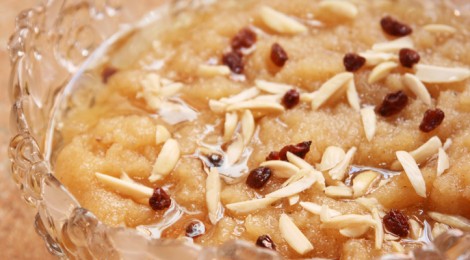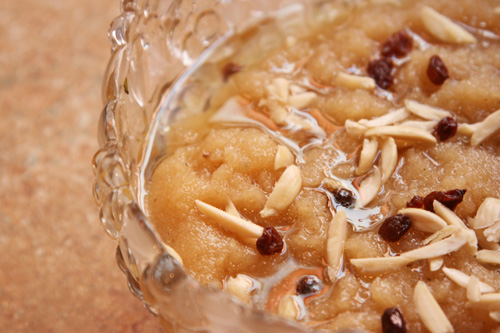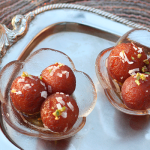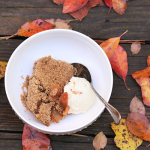
Sooji (Semolina) Halwa
Halwa has to be one of my favourite desserts. It can be made with such a variety of ingredients and the best thing is that each has a unique and individual taste. It would be difficult to pick out a favourite- gajar halwa , pumpkin halwa, besan halwa, sooji halwa, sohan halwa, habshi halwa and the list goes on. Basically, the main ingredient is cooked in oil and sugar, and in some cases, milk. It sounds simple enough, but it’s one of those things that if you can make good halva, then people will know that you’re a good cook.
I wasn’t a big fan of sooji halwa served as a dessert when I was growing up; I associated it with occasions like milaads, khatams and funerals. Also, it was usually kind of dry and crumbly. It was AWESOME with channas and poori, though! Halwa poori is the best breakfast ever! It tasted much better too because it is kept especially soft and moist when served with pooris. But I really started enjoying it when I learnt to make it just how I like it :).
SOOJI (SEMOLINA) HALWA
My mother-in-law first taught me how to make this halwa. She was making it and I was just hanging out with her in the kitchen. And during the course of our conversation she would just point out what she was doing. She always did that when I first got married- whenever we were in the kitchen and she was making something, she would just outline the steps for me, giving me a lot of useful tips. Like a lot of girls, I only started cooking after I got married. So while I could do basic cooking and follow a recipe, she did make sure to show me whatever she could in the kitchen.
Sooji halwa can be made in a number of ways. This method makes what is called the ‘makhadi halwa.’ Color may be added, the most popular being pink, yellow or orange. But the expert cook will be able to give the sooji a beautiful golden color by caramelizing the sugar to just the right degree. It’s hard to achieve and needs practice, so initially it would be better to play it safe and go ahead with the pale color which is perfectly acceptable, and in fact, more popular.
This dessert is especially great on a chilly, rainy/overcast day. The soft, warm dessert just warms you from the inside and makes you feel all cozy… mmm.
The texture should be soft and smooth. It will set when cooled and may be eaten warm or cold. This makhadi sooji halwa is not suitable for serving with halwa poori.
Ingredients
1 cup sooji (semolina)
1¼ cups sugar
1 cup oil
1 cup water + more for soaking sooji
¼ tsp (heaped) green cardamom powder
Raisins & slivered almonds for garnishing (or any nuts of your choice)
[Update: In Pakistan, we used 1 cup of sugar for 1 cup of sooji. In the US, the sugar is not as sweet, so the quantity is increased.]
Method
1. Measure the sooji in a bowl and completely cover with water (about 2- 2½ cups of water). Soak for at least 15 minutes.
2. Heat the oil and sugar in a pan over medium low heat until the sugar has melted and completely dissolved.
3. Just as the sugar mixture starts to change to a pale golden color (watch the sugar carefully as it can burn very quickly), add the sooji without draining the water. Add the 1 cup of water. Be careful as the mixture will be very hot and will splatter when water is added. Stir constantly using a metal or wooden spoon. (Non-stick utensils will not be able to withstand the high temperature of the sugar.)
Note: The sugar will solidify when you add the sooji. Don’t panic! It will melt as you stir.
4. The halwa will be bubbling as all the water evaporates. Add the green cardamom.
5. Stir fry on medium heat until all the water evaporates from the mixture and the halwa emits a ‘roasted’ smell, around 8 minutes. The sooji should not have a raw, powdery taste or smell at this point. It will also start to ‘leave’ the sides of the pan/pot. If, with the bubbling oil, you can’t tell when it’s ‘done,’ then watch until it just starts to change color. This will happen only when all the water has evaporated. Remove from heat immediately. Be careful not to overcook it.
6. Put into a serving bowl and garnish with nuts and raisins.
Troubleshooting
I have made all the mistakes that one can possibly make when making this halwa:
1. Too little oil: The halwa will stick to the bottom of the pan when it’s done and will be a bit dry.
2. Too much oil: Just pour out the excess after it’s cooked. I like to leave at least some of the oil in as it keeps the halwa moist.
3. Too little water: You will end up with lumpy halwa and it won’t be as soft or moist. Some people like it this way.
4. Too much water: The halwa is quite forgiving in this event. Eventually it will evaporate and make the halwa soft.
5. Too little sugar: The general rule is you can’t add more sugar after the halwa has been cooked. But my experience is if you taste it as soon as it’s done and feel like it needs more, then add some as quickly as possible while it’s still warm and soft and you will be able to mix it in. The other option is to caramelize the sugar – you will have a good chance of mixing the sugar in properly when it’s in liquid form.
6. Too much sugar: Eat it a liiiittle bit at a time.
7. Sugar doesn’t dissolve in the oil and forms lumps: The heat was too high. Turn down the heat and add a little bit (about ¼ cup) of water while stirring. The sugar will dissolve.
8. Over-browned sugar: Throw it in the trash.
9. It turns dark and sticky: You over-cooked it.
[Update: Tip: I use wooden spoons, so I have reserved one for desserts. Wood is porous so it absorbs flavors, and I don’t want a ‘masala‘ taste in my desserts.]
Please ‘like’ Zabiha Bites on Facebook.
Related Post:











Amna I just live your recipes .I have made this and kaddu halwa and they both turned out just great !! I don’t even have to look for troubleshooting anywhere else. You’ve sorted everything out right here. Thankyoy so much !
Love you, Umena.
I have tasted the rather smooth, mushy, and soft pudding like consistency suji halwa in Pakistan that usually is sold with puri for breakfast….i been making halwa for years but never attained that texture….can you advice how to achieve that soft and smooth texture halwa??
Safina,
This recipe is not for the soft halwa-puri halwa. That uses a different ratio of water to sooji. I’m planning to do a post on that halwa, but for now I will email it to you :).
Hey ! I want ur suggestions for the problems I had in cooking it though I followed ur steps exactly.
1. My sugar bcm solid in frying initially Though it was on the lowest mark.
2. Added little water as u said so it took time to dossolve.
3. I’m so fond of this halwa but my recepie never turned well so I searched for another nd found urs.ur pic looks amazing but can u do a favour for ppl like me , if u cook it again kindly take a pic of a spoon been digging out the halwa frm bowl.
Then it will be better to understand the texture of final step.
4. Thanks so much for mentioning the troubleshoot bullets as well it really helps nd u must hv done a big effort on this blog I believe.wish u all luck.
Hello Kanwal! Thank you for your kind words.
I will keep your request in mind when I make this halwa next time. You can also visit my facebook page at https://www.facebook.com/ZabihaBites and if you go to the Readers’ Images album (https://www.facebook.com/media/set/?set=a.192056590931782.50433.165412686929506&type=3) you will find a few more pictures. Thanks!
hey i made it today and i really like the texture but need to know which oil you use for this recipe? I generally use butter in halwa but since yours said oil, i used canola oil and halwa had some oily flavor which i wish wasnt there. Do let me know? otherwise i am really thankful for this recipe as my baby ate it with so much interest 🙂
Hey Saira! I use canola because of its neutral flavor. But since there is a large quantity used, I suppose it might stand out if you’re more sensitive to it. Safflower oil is believed to be almost tasteless so you might want to try that. Another almost tasteless oil is corn oil, which has a little corn flavor at room temperature but loses it when heated up.
Whenever I made Halwa Raabia said it does not taste like Bibian,Iam going to try your recipe and see how it turns out.
Halima farina halwa will be different in texture it will be sticky as glue
Thank you for this valuable bit of information!
That makes perfect sense because semolina is made from durum, which is the variety of wheat containing the least amount of gluten.
Gluten is the protein that provides binding power and elasticity.
Farina is made from other wheat varieties, resulting in a higher gluten content, which means more ‘sticking’ power, hence halwa made with farina is more gummy and sticky.
Good that you have started with a sweet dish. I hope that your blog is very successful meri jan and it is bound to be considering your talent and your hard work masha Allah.
Your father loved halwa and if he had been alive today, he would have been so happy and proud of you. I will definitely make it according to your recipe and offer fateha for the blessing of his soul.
Love you meri jan
Ammi
I love halwa, it’s definitely my favorite desi dessert, for the same reason you mentioned: it just warms the soul. I’m actually trying to figure out why I never tried to make it before. You take so much guess work out of the equation that I’ve decided to try it, I just have a few questions:
I don’t feel like making a trip to the Indian store and I’ve heard farina is similar to sooji, do you think the recipe would work with farina?
Also, I’m not a fan of raisins, do you have any other garnish suggestions?
Halima, semolina refers to coarse wheat particles that are a by-product of wheat processing, and is made from a ‘hard’ variety of wheat (durum). When this by product comes from processing softer wheat varieties, it is known as farina.
I’ve never tried making this halwa using farina but I would encourage you to give it a try. They are really very similar so I think it is possible to use it as a substitute.
You can use any nuts of your choice for garnishing. Typically, slivered almonds and coconuts are used. Pistachios and cashews are also an option.
Do let us know how it turns out!
My favorite part of the recipe is the trouble shooting. Such.great advice and tips! I can’t wait to try this recipe! Sooji ka halwa always reminds me of my grandmother. Thank you for giving me a little piece of her back.
Raabia your comment made me tear up.